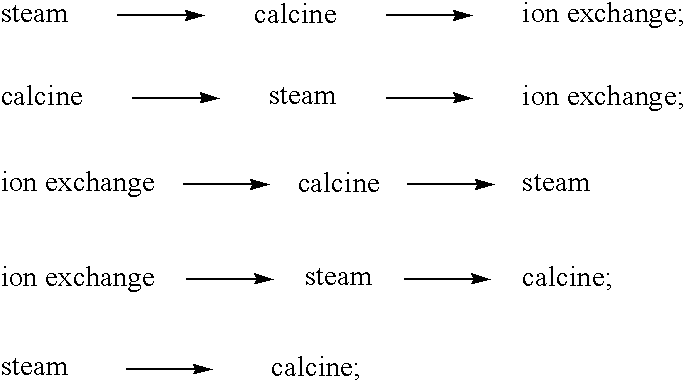Dual functional catalyst for selective opening of cyclic paraffins and process for using the catalyst
a technology of cyclic paraffin and selective opening, which is applied in the direction of physical/chemical process catalysts, metal/metal-oxide/metal-hydroxide catalysts, hydrocarbon preparation catalysts, etc., can solve the problem of refiners facing the problem
- Summary
- Abstract
- Description
- Claims
- Application Information
AI Technical Summary
Benefits of technology
Problems solved by technology
Method used
Image
Examples
example 1
[0065] An aluminum sol was prepared by dissolving aluminum metal in HCl. In a container 822.4 g of the Al-sol, containing 105.32 g Al (as Al2O3) and 94 g Cl were blended with 2.91 g of NbCl5 at 60° C. for 12 hours. To this there were added 302.1 g of hexamethylene tetraamine (HMT) and 15.4 g of water. Droplets of the resulting mixture were formed and dropped into a hot oil tower which formed gelled spheres. The spheres were then aged at 140° C. for 1.5 hours, washed with 20 liters of 0.25% NH3 solution for 2 hours at 95° C., dried at 100° C. for 16 hours and then calcined at 550° C. for 2 hours in air with 3% steam.
[0066] In a rotary impregnator, 50 cc of the above spheres were impregnated with a 50 cc aqueous solution containing 8.89 cc of chloroplatinic acid (CPA) (Pt concentration was 28.08 mg Pt / cc) and 2 g of HCl (37%). The excess solution was evaporated at 100° C. and the catalyst was then calcined at 525° C. in flowing air (3600 cc / min.) and 45 cc / min. of 1.0M HCl for 30 min...
example 2
[0067] In a container 766.2 g of alumina was mixed with 27 g HNO3 (70%) followed by the addition of 71.4 g TiO2 and 563.9 g of water and mixed for 30 minutes to form a dough. The dough was extruded through a 0.073″ dieplate and the extrudates calcined in air at 550° C. for two hours.
[0068] In a rotary evaporator, 72.26 g of the above extrudates were combined with 100 ml of an aqueous solution containing 4.92 ml of HCl (37%) and 12.8 ml of CPA. The solution was evaporated and the catalyst was calcined and then reduced as described in Example 1. Analysis of the catalyst showed it contained 0.49 wt. % Pt. This catalyst was identified as catalyst B.
example 3
[0069] In a rotary evaporator 148.24 g of gamma alumina extrudates were impregnated with 200 ml of an aqueous solution containing 26.03 mL of CPA, 1.60 g La(NO3)3 and 9.99mL HCl (44%). The wet powder was dried, calcined and reduced as described in Example 1. Analysis of the catalyst showed it contained 0.5wt. % Pt and 0.32wt. % La. This catalyst was identified as catalyst C.
PUM
| Property | Measurement | Unit |
|---|---|---|
| wt. % | aaaaa | aaaaa |
| pressure | aaaaa | aaaaa |
| temperature | aaaaa | aaaaa |
Abstract
Description
Claims
Application Information
 Login to View More
Login to View More - R&D
- Intellectual Property
- Life Sciences
- Materials
- Tech Scout
- Unparalleled Data Quality
- Higher Quality Content
- 60% Fewer Hallucinations
Browse by: Latest US Patents, China's latest patents, Technical Efficacy Thesaurus, Application Domain, Technology Topic, Popular Technical Reports.
© 2025 PatSnap. All rights reserved.Legal|Privacy policy|Modern Slavery Act Transparency Statement|Sitemap|About US| Contact US: help@patsnap.com

